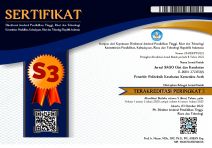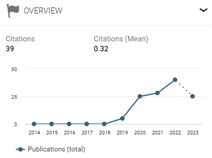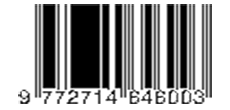Hubungan antara pola asuh pemberian makan dan status gizi pada anak usia 3–6 tahun di Bekasi
DOI: 10.30867/gikes.v6i1.2150Abstract
Background: Proper feeding parenting patterns can help ensure that children get balanced and sufficient nutritional intake, which has an impact on good nutritional status.
Objectives: This study aims to identify the relationship between parenting patterns and nutritional status in children aged 3-6 years.
Methods: The research design used was cross-sectional with chi-square bivariate analysis test. This research was conducted at KB & TK Kupu-kupu Mungil, Bekasi Regency in May 2024. The research subjects were selected randomly using a simple random sampling technique by considering the inclusion and exclusion criteria of the research, and 80 respondents were obtained. Data were collected using the Child Feeding Questionnaire (CFQ), and anthropometric measurements of children's height and weight.
Results: This study showed the results of 66,3% of parents have college, 40% work as private employees, work as private employees. The results showed that 65% of parents have good eating control, and 67,5% of children have normal nutritional status. In terms of food supervision, the majority of parents (66,3%) consistently monitor their children's consumption of sweet foods, and 52,5% often record snack consumption. Most children in the normal nutritional status category are in the good parenting group, namely 44 children (84,6%).
Conclusion: Good parenting patterns can have an impact on good nutritional status in children aged 3-6 years.
Keywords
Full Text:
PDFReferences
Adimuntja, N. P., Pamangin, L. O. M., & Asriati. (2023). Pola Asuh Pemberian Makan Balita dalam Upaya Pencegahan Stunting di Kota Jayapura. Preventif : Jurnal Kesehatan Masyarakat, 14(3), 512–528. https://doi.org/10.22487/preventif.v14i3.971
Alabi, O. D., Malnutrition, G. O., Sahara, S., & Intervention, A. (2024). Malnutrition intervention programmes for school children in Sub - Saharan Africa : a review. Food Research, 8(February), 113–126.
Al Rahmad, A. H., Salsabila, J. S., Erwandi, E., & Fadjri, T. K. (2024). Pengembangan Leaflet Pencegahan dan Pengendalian Overweight Sebagai Media Penyuluhan dalam Meningkatkan Pengetahuan. Jurnal Bahana Kesehatan Masyarakat (Bahana of Journal Public Health), 8(2), 82-88.
Astuti, T. W. (2014). Hubungan pola asuh pemberian makan dan perilaku makan dengan kejadian obesitas pada anak pra sekolah di kota magelang. Universitas Gadjah Mada, Yogyakarta.
Birch, L. L., Fisher, J. O., Grimm-Thomas, K., Markey, C. N., Sawyer, R., & Johnson, S. L. (2001). Confirmatory factor analysis of the Child Feeding Questionnaire: A measure of parental attitudes, beliefs and practices about child feeding and obesity proneness. Appetite, 36(3), 201–210. https://doi.org/10.1006/appe.2001.0398
Ek, A., Sorjonen, K., Eli, K., Lindberg, L., Nyman, J., Marcus, C., & Nowicka, P. (2016). Associations between Parental Concerns about Preschoolers ’ Weight and Eating and Parental Feeding Practices : Results from Analyses of the Child Eating Behavior Questionnaire , the Child Feeding Questionnaire , and the Lifestyle Behavior Checklist. PLOS ONE, 11(1), 1–20. https://doi.org/10.1371/journal.pone.0147257
Hendra, A., Rahmad, A., & Miko, A. (2016). Kajian stunting pada anak balita berdasarkan pola asuh dan pendapat keluarga di Kota Banda Aceh. J Kesmas Indones, 8, 63-79.
Ilijoski, I., Poposka, A., & Jovanoska, D. (2013). Nutritional Status , Diet And Malnutrition Assessment , And Early Detection Of Health Risks From Chronical Non-Contagious Diseases At Preschool And School Children. Journal of Hygienic Engineering and Design, 4.
Jumiatun, J. (2019). Hubungan Pola Pemberian Makanan dengan Status Gizi Balita Umur 1-5 Tahun di Desa Ngampel Kulon Kecamatan Ngampel Kabupaten Kendal. Jurnal Kebidanan Harapan Ibu Pekalongan, 6(5), 218–224. https://doi.org/10.37402/jurbidhip.vol6.iss2.58
Kemenkes RI. (2023). Survei Kesehatan Indonesia (SKI) Dalam Angka. In Survei Kesehatan Indonesia dalam Angka. Badan Kebijakan Pembangunan Kesehatan.
Leuba, A. L., Meyer, A. H., Kakebeeke, T. H., Stülb, K., Arhab, A., Zysset, A. E., Leeger-Aschmann, C. S., Schmutz, E. A., Kriemler, S., Jenni, O. G., Puder, J. J., Munsch, S., & Messerli-Bürgy, N. (2022). The relationship of parenting style and eating behavior in preschool children. BMC Psychology, 10(1), 1–10. https://doi.org/10.1186/s40359-022-00981-8
Lwanga, S., & Lemeshow, S. (1997). Sample size determination in health studies. In Sample size determination in health studies (pp. 55–62).
Nadhila, L. F., Gita Ningrum, A., & Tri Arif Sampurna, M. (2023). Effect of Parenting Style on Nutritional Status of Toddlers in Surabaya. Indonesian Midwifery and Health Sciences Journal, 7(3), 267–275. https://doi.org/10.20473/imhsj.v7i3.2023.267-275
Nirmalasari, R., Aldianor, A., Asfari, E. P., Anand, R., Septiani, R., & Nurhalisa, S. (2021). Penguatan Pola Asuh Terhadap Tumbuh Kembang Anak Usia Dini Dalam Keluarga Melalui Pemberdayaan Masyarakat Di Desa Petak Bahandang. SELAPARANG Jurnal Pengabdian Masyarakat Berkemajuan, 5(1), 270. https://doi.org/10.31764/jpmb.v5i1.4816
Nurlan, F., Atika, N., & Ulfia, W. (2019). Karakteristik Ibu dan Pola Asuh Praktek Pemberian Makan Pada Anak Usia Bawah Dua Tahun (Baduta). Al-Maiyyah, 12(2). https://almaiyyah.iainpare.ac.id/index.php/almaiyah/article/view/700/495
Octarya, N., Dewiani, K., Yusanti, L., Suriyati, Novianti, & Yulyani, L. (2022). The Relationship of Parenting Feeding Paterns to The Occurrence of Undernutrition in Children Under Five. Journal of Health Sciences and Medical Development, 1(01), 12–19. https://doi.org/10.56741/hesmed.v1i01.31
Pademme, D. (2020). Gambaran Kejadian Stunting Berdasarkan Karakteristik Ibu di Puskesmas Aifat Kabupaten Maybrat. GLOBAL HEALTH SCIENCE (GHS), 5(2), 69–72.
Prakhasita, R. C. (2019). Hubungan Pola Pemberian Makan Dengan Kejadian Stunting pada Balita Usia 12-59 Bulan di Wilayah Kerja Puskesmas Tambak Wedi Surabaya. In Ir-Perpustakaan Universitas Airlangga Skripsi.
Purwani, E., & Mariyam. (2013). Pola Pemberian Makan Dengan Status Gizi pada Anak 1 sampai 5 Tahun di Kabuman Taman Pamalang. Jurnal Keperawatan Anak., 1(1), 30–36.
Putri, M. R. (2018). Hubungan Pola Asuh Orangtua Dengan Status Gizi Pada Balita Di Wilayah Kerja Puskesmas Bulang Kota Batam. Jurnal Bidan Komunitas, 11(2), 107–116. http://ejournal.helvetia.ac.id/index.php/jbk
Putri, S. M. A. (2019). Pengaruh Status Pekerjaan Ibu Terhadap Asupan Energi Dan Status Gizi Pada Anak Usia Prasekolah Di Tk Aisyiyah Pajang Dan Karangasem Kecamtan Laweyan Surakarta. Universitas Muhammadiyah Surakarta.
Rakhmawati, N. Z., & Panunggal, B. (2014). Hubungan pengetahuan dan sikap ibu dengan perilaku pemberian makanan anak usia 12-24 bulan. Journal of Nutrition College, 3(1), 43–50.
Sodikin, Endiyono, S., & Rahmawati, F. (2018). Pendahuluan. Jurnal Ilmu Keperawatan Anak, 1(1), 8–14.
Suryani, S., Agustriyani, F., Palupi, R., & Ardinata, A. (2022). The Correlation Between Parenting Style and Picky Eater Habits on The Preschool Students. Journal of Current Health Sciences, 2(2), 61–66. https://doi.org/10.47679/jchs.202240
UNICEF. (2024a). Brief Guidance Note: Age prioritization of nutrition interventions for child survival, growth and development in resource-constrained contexts.
UNICEF. (2024b). Parenting Support Framework for the Early Years.
WHO. (2007). World Health Organization. AnthroPlus for Personal Computers. Manual: Software for assessing growth of the world ’ s children. In Geneva. http://www.who.int/growthref/tools/en/
WHO. (2019). WHO Anthro Survey Analyser Quick guide.
Windiani, I. G. A. T., Agustini, N. K. W., Adnyana, I. G. A. S., Soetjiningsih, S., & Murti, N. L. S. P. (2021). The Association Between Nutritional Status and Risk of Developmental Disorder in Children in Denpasar Bali Indonesia. Journal of Medical Sciences, 9(9(B)), 687–691.
Wulandari, H., & Nurhaliza, R. (2024). Pengaruh Pola Asuh Orang Tua dalam Meningkatkan Prestasi Belajar Anak Usia Dini. Jurnal Ilmiah Wahana Pendidikan 10, 10(13), 682–687.
Yamborisut, U., Visetchart, P., Thasanasuwan, W., Srichan, W., & Unjana, R. (2018). Parental feeding practice is associated with child ’ s body mass index in Thai school-aged children. Journal of Heatlh Research, 32(1), 82–94. https://doi.org/10.1108/JHR-11-2017-010
Yuliarsih, L., Muhaimin, T., & Anwar, S. (2020). Pengaruh Pola Pemberian Makan Terhadap Status Gizi Balita Di Wilayah Kerja Puskesmas Astanajapura Kabupaten Cirebon Tahun 2019. Syntax Literate : Jurnal Ilmiah Indonesia, 5(4), 82–91.
Zembura, M., Lula, P., & Matusik, P. (2023). Ten-Year Differences in Nutritional Status and Obesity-Related Risk Factors in Polish Preschool Children. Children, 10(636), 1–11.
Refbacks
- There are currently no refbacks.













